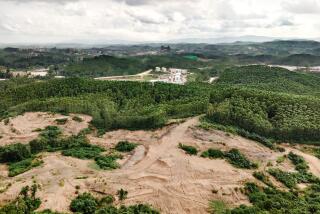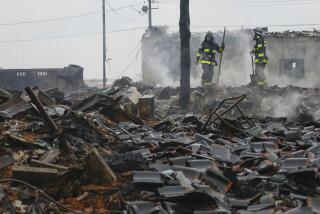Jealousy Over Tsunami Aid Divides Village
PERALIYA, Sri Lanka â It was different, people here tell you, in those first few days after the ocean came roaring over the horizon and slammed into Peraliya, driving trees and boulders through the village and leaving behind more grief than anyone had thought possible.
Tsunami survivors shared water, food and what medicine they could scrounge. Some passed shovels back and forth, searching for survivors. Others stared at one battered corpse after another, trying to figure out which body belonged to which family.
Itâs how things are supposed to work in places like Peraliya, a community of fishermen and small traders where families, friendships and neighborhoods are woven into an intricate web.
âThe whole village was like one familyâ in those early days, said Sriyawathi Malani Gunathilaka, who lost her only son to the waves. âWe shared the sadness.â
But six months later, the community that has inhabited this sandy land for generations is coming apart, its social networks snapped by jealousy over which family gets how much aid money and how soon. The resentment is magnified by officials who have left villagers desperate for information about what will happen to them.
The Dec. 26 tsunami killed about 450 people from Peraliya and an adjoining village, and more than 31,000 across Sri Lanka. Hundreds of villagers here, and some 900,000 people elsewhere on the tropical island, were left homeless.
Itâs the aftermath, though, that may destroy Peraliya.
âEverything has changed completely,â said Sriyawathi, sitting on a water-stained easy chair, one of the few pieces of furniture left after the waves knocked down most of her house. The cushions smell of mold and dirt. âItâs all about the jealousy.â
On the surface, Peraliya, like hundreds of other coastal villages, looks immensely better than it did in late December. Within days of the tsunami, help began pouring in. Vacationing surfers helped put up tents and local politicians brought truckloads of food. Within a couple weeks, the professional aid community had dispatched teams throughout Sri Lanka.
Peraliya still looks like a battle scene, with half-built structures, piles of wreckage and spaghetti-like coils of wiring strung haphazardly.
On some days, only a few dozen people loll around a village where more than 1,500 once lived. Hundreds of villagers have moved in with relatives, found cheap shacks to rent elsewhere, or become squatters inland. Even some of the new houses remain empty much of the time.
But even the poorest villagers now have somewhere dry to sleep, though sometimes itâs just a wooden shack. Everyone gets a few dollarsâ worth of rice and other essentials each week. Homes -- real homes of concrete and brick -- are finally going up.
Promises of more to come dance around the village. Politicians talk of land, and visiting foreigners talk of engines for fishing boats. Always, thereâs talk of cash.
And thatâs the problem.
The trouble can be heard in the grumbling among the fishermen, who have split into rival factions. Itâs in the silence between neighbors. Itâs in the virulent undertow of whispers and the relentless covetousness of people who have lost everything.
âEveryone is angry at someone,â said Manjula Jayasiri, a fisherman squatting on the floor of his temporary home, a wooden shack built with Danish aid money. Around him, a small group of friends and relatives shouted in agreement. âSince the tsunami, the whole village is divided.â
If Jayasiri is exaggerating, itâs not by much.
People still living in temporary shelters are angry at those with houses. Fishermen with no boats are angry at those who received them. People whose homes were within 110 yards of the ocean are angry that the government has said they must move. Many villagers are angry at the committee formed to decide how to distribute the handouts that poured in.
It takes little to drag someone into the bitterness.
Sriyawathi is a formidable matriarch who worked desperately to keep her family out of poverty, particularly after her husband was slowed by a stroke. Her drive had left her with few close friends, but she was still cared about in the village. Her neighbors mourned with her over the loss of her 19-year-old son and worried when she cried long into each night.
Now, some neighbors have cut ties with her, jealous that a Buddhist monk raised money for a well-built foundation and reinforced columns for her familyâs new house, while other nearby homes, though put up more quickly, were built with poorer materials.
One neighbor, who had allowed Sriyawathi to splice into her electricity connection, said the line had to go. Another neighbor doesnât speak to her anymore.
The degree of jealousy perplexes Sriyawathi. She says that her family -- not the monkâs charity -- will be responsible for building most of her new house.
She has emerged from the worst of the pain of her sonâs death and has started putting her familyâs life back on track. She has become increasingly knowledgeable about aid applications, and helps oversee the men building the houseâs foundation.
She doesnât have time, she says, to worry about the bitterness that has engulfed the village. Still, sheâs saddened by it.
âI donât know what we have to be jealous of,â she said.
Given the bitterness, it seems strange that thereâs one thing Sri Lanka doesnât lack: reconstruction money.
Pledges of $3 billion in international aid and debt relief poured into the country after the tsunami, and despite the half-built, half-destroyed feel of most villages, aid officials insist things will improve dramatically over the next year. Enough money was pledged to rebuild roads, schools and houses, experts say.
âIâm absolutely not going to paint a picture that everything is fine, but there is a huge amount of activity that has already started, and an even larger amount of activity that is set to go,â said Peter Harrold, the World Bank chief for Sri Lanka.
What there isnât, though, is information. If the money is out there, no one has told the people of Peraliya -- and most other villages -- how it will reach them. Top regional officials have visited for a few memorial services.
The people who live within the 110-yard coastal buffer zone have heard theyâll be given land in a forest about six miles away. But no one has seen the land or knows anything about the houses that will be built there.
The government insists things are going well. A recent headline in the government-run Daily News said Sri Lankaâs program to distribute foreign relief money had won âglobal praise.â
Few villagers would agree.
âWe donât have anything,â said Jayasiri, the fisherman. His house was in the buffer zone, and as new homes have been erected nearby, he has become terrified that he will be left with nothing. âWe donât even know where weâre going, and someone a few meters away already has a house?â
More to Read
Sign up for Essential California
The most important California stories and recommendations in your inbox every morning.
You may occasionally receive promotional content from the Los Angeles Times.









